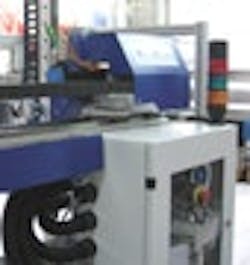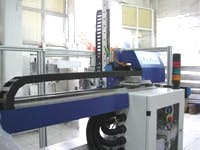In–Mold Labeling Robot Adds Axes
Why put a label on a package when you can make the label part of the package? That’s the logic behind in-mold-labeling (IML) technology, as well as the inspiration for efforts to integrate it with injection-molding machines. However, doing IML successfully and efficiently requires plenty of automation and motion control.
Engineers and technicians at RoboPlas in Istanbul, Turkey, have been making single-axis IML robots with pneumatic controls for four years, which was 12 months before the company itself was established. This past October, RoboPlas released its RP1 robot that has three servo-driven axes and all-electronic controls.
Basically, IML inserts one or more labels into the injection mold process before a product is formed, and those labels meld and merge with the plastic itself, which is far more secure than stuck-on or printed labeling. RoboPlas reports that IML is growing in the U.S., as well as in Europe and the Middle East.
Inject-a-Label
RoboPlas’ RP1 in-mold labeling robot uses three servo-driven axes to insert multiple labels into injection-molding processes.
Source: RoboPlas
Zafer Kirik, RoboPlas’ head of manufacturing and executive partner, explains that RP1 is his company’s first design that can be added directly onto an existing IML system and machine. “We decided to build RP1 now because we needed to keep up with our market and the needs of our customers, but it wasn’t too hard because the design didn’t have to be completely new,” he says. “It was integrated with existing equipment.”
Besides demanding more speed, RoboPlas’ users wanted an IML system that could remove any damaged products from the process. Kirik says RP1 incorporates a camera or a light-sensitive sensor that can inspect items on the production line and sort out items that don’t meet specifications. He says RP1’s predecessor equipment is used by Emirates Plastics Industry (EPI) in Dubai, United Arab Emirates; by Helioplast, which makes buckets for chocolate in Bosnia and Herzegovina; by HTI Group, which makes buckets for paint in Kyrgyzstan; by many food manufacturers in Turkey; and by other users in Serbia and Iran.
The new robot’s components include Schneider Electric’s Lexium 05 servos and related motion control components, Advantis OT distributed I/O devices and Altivar 31 A/C drives. RoboPlas reports these improvements give RP1 more accurate position control and stability and the ability to use high-torque servo motors and more accurate linear bearings.
The trend for injection molding is to have machines that can increase the number and type of different products than they can do with one press, explains Kirik. “Even though it’s better for a machine builder’s customers to have multi-function machines, it can mean more problems for the builder,” he says. “We have to balance this with the fact that it’s better for us to have one machine that does one job at a time, so we can standardize production and deliver the same quality at less cost. On the IML side, we’ve been able to greatly increase the number of labels we can place inside a mold in one shot. In fact, if the end product is large enough, we can provide up to 48 labels in one very large mold.”
For the future, Kirik says RoboPlas is looking at how IML might be used in blow-molding applications.


